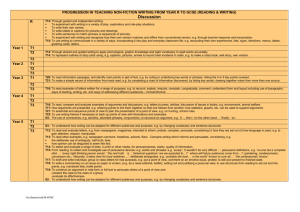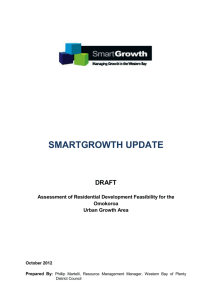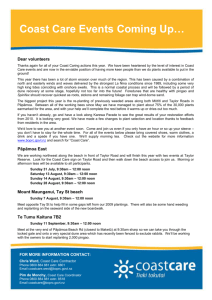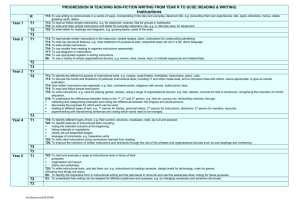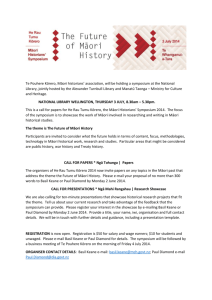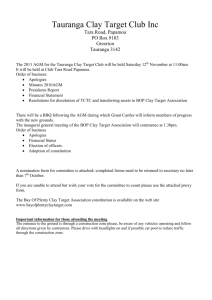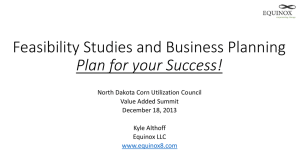Assessment of Residential Development Feasibility
advertisement
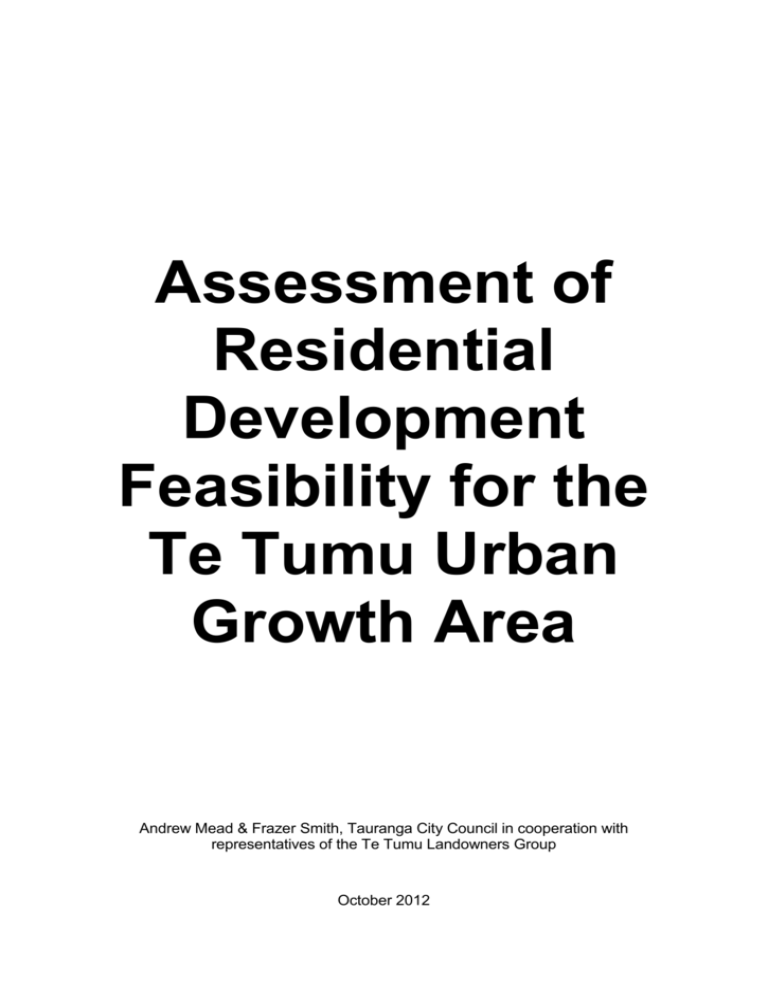
Assessment of Residential Development Feasibility for the Te Tumu Urban Growth Area Andrew Mead & Frazer Smith, Tauranga City Council in cooperation with representatives of the Te Tumu Landowners Group October 2012 Table of Contents 1. Executive Summary...................................................................................................... 3 2. Report structure............................................................................................................ 4 3. Purpose ......................................................................................................................... 5 4. Background ................................................................................................................... 6 4.1 4.2 4.3 4.4 4.5 4.6 4.7 5. Development Feasibility Methodology / Data Inputs................................................. 9 5.1 5.2 5.3 5.4 5.5 5.6 5.7 5.8 5.9 6. Base model results ........................................................................................ 15 Comparison with developers own modelling .............................................. 16 Sensitivity analysis ........................................................................................ 16 Comparison with Wairakei financially modelling ........................................ 16 Other Issues ................................................................................................................ 17 7.1 7.2 7.3 7.4 8. Project team ...................................................................................................... 9 Land development model ................................................................................ 9 Key modelling assumptions ............................................................................ 9 Revenue inputs ............................................................................................... 10 Cost inputs ...................................................................................................... 10 Inflation............................................................................................................ 12 Financial analysis ........................................................................................... 13 Timing of revenues and costs ....................................................................... 13 Goods and services tax ................................................................................. 14 Residential development feasibility results ............................................................. 15 6.1 6.2 6.3 6.4 7. Location............................................................................................................. 6 History ............................................................................................................... 6 Current land uses and land owners ............................................................... 6 Growth projections........................................................................................... 7 Infrastructure servicing ................................................................................... 7 Infrastructure costs .......................................................................................... 8 The importance of considering the financial viability of development ....... 8 Tsunami risk ................................................................................................... 17 Council debt .................................................................................................... 17 Alternative infrastructure servicing approaches......................................... 17 Development viability challanges in other parts of the eastern corridor.. 18 Conclusions ................................................................................................................ 19 1. Executive Summary The primary purpose of this research is to assess the financial viability of development in the Te Tumu urban growth area which is an area of around 760ha earmarked for future development (mainly residential development) in the current SmartGrowth Strategy. To assess the feasibility of development in Te Tumu the hypothetical development model that was built for the 2010 Wairakei development feasibility project by Tauranga City Council was used. This is a Microsoft Excel spreadsheet based model that includes all of the costs and revenues associated with land development and the timing thereof. The model allows the financial performance of a development proposal to be calculated from the perspective of the developer. The model itself is very similar to that used for most major property developments. All of the scenarios that were modelled performed well and would be financially viable. Given the conservative nature of some of the assumptions used in the modelling e.g. inclusion of Kaituna Link project in the development contributions and the lower than anticipated yields, it may well be that development would actually be more profitable than is indicated by the modelling. As a means to check the validity of the modelling results, the Carrus representative in the project team used their own development feasibility model with their own cost inputs. The results showed that the development of Te Tumu was viable confirming the results provided by the TCC model. This provides comfort that the conclusions of this research are reasonable. It should be noted that the issue of tsunami risk was not considered in this work as it is still an unknown. If significant additional development costs are required to mitigate this risk it may affect the conclusions drawn in this research. Putting aside the tsunami issue, there is no reason why the current SmartGrowth Settlement Pattern needs to be altered in respect of Te Tumu. It is logical that development of Te Tumu is staged to commence once development of Wairakei is substantially underway as is currently planned. It would however be prudent to continue work that has already commenced to see whether there are more cost effective ways of providing infrastructure to service Te Tumu. This may: Identify ways in which development in Te Tumu could commence at an appropriate time without the need for significant lead infrastructure investment by Council that would need to be debt funded Allow development costs to be reduced which would make it possible to deliver housing that is more affordable Include investigation of alternative connection options between Papamoa East (Wairakei and Te Tumu) and the Tauranga Eastern Link motorway from the current grade separated interchange that is proposed e.g. a roundabout. 2. Report structure This Report is structured as follows: Purpose Background Development feasibility methodology and data inputs Residential development feasibility results Other issues Conclusions Recommendations Appendices. 4 3. Purpose The purpose of this project is to: a) Assess the financial viability of residential development in the Te Tumu urban growth area given: The prominent role Te Tumu is planned to have in accommodating the city and sub region’s future population growth The influence it is likely to have on the success of other urban growth areas, especially the planned Rangiuru Business Park and the planned town centre in Wairakei The importance of Te Tumu to enable Council to fund the costs of major planned infrastructure projects such as the Papamoa East interchange and the Waiari water treatment plant. The importance of Te Tumu to the optimisation of the Tauranga Eastern Link and to the toll funding model for this project. b) Identify other issues or challenges to development in Te Tumu aside from financial viability. c) Identify measures that could improve financial viability and/or address other issues that are identified. 5 4. Background This section of the Report provides background information on the Te Tumu urban growth area. 4.1 Location 4.1.1 The Te Tumu urban growth area is located in Papamoa East, around 20km from the Tauranga City Centre. It is bounded by the Pacific Ocean to the north, the Kaituna River and rural land to the east and south and the Wairakei urban growth area to the west in which residential development is now underway (see map in Attachment A). 4.2 History 4.2.1 Te Tumu has been identified for future urban development by Tauranga City Council for some time. The role of Te Tumu as a future urban growth area was formalised through the SmartGrowth Strategy in the early 2000’s and subsequently through Change 2 to the Bay of Plenty Regional Policy Statement. Te Tumu was rezoned from Rural to Future Urban in the recent TCC City Plan review. Tauranga City Council does not anticipate urban development commencing in Te Tumu for over 10 years. 4.3 Current land uses and land owners 4.3.1 The majority of the Te Tumu land area of over 760ha is currently used for farming purposes. Other lesser land uses include forestry, sand mining, market gardening and a small number of lifestyle blocks. Approximately 450ha of the total land area is assessed as being developable land free of planning constraints. 4.3.2 Most of the land holdings in Te Tumu are large although there a small number of more fragmented blocks throughout the area. Close to 90% of the Te Tumu land area is owned by three parties: 4.3.3 Te Tumu Kaituna 14 Trust – 240ha approximately Hickson Block (TCC/WBOPDC with option for Carrus to buy back) – 170ha approximately Ford Block – 245ha approximately. It is envisaged that the Hickson and Ford blocks would be primarily developed for residential purposes, while the Te Tumu Kaituna 14 block would be primarily developed for non-residential purposes. 6 4.4 Growth projections 4.4.1 The 2011 SmartGrowth population projections envisage a long-term population of about 19,000 people in Te Tumu. This population could be significantly higher or lower depending mainly on the development yields that are achieved. If an average of 15 lots per hectare of net developable area was achieved the total population might only be around 12 or 13,000. However if medium and high density development is viable the population could be upwards of 25,000 people. The current plans of the landowners in Te Tumu envisage a population in the mid to high 20,000’s. To achieve this probably about 50% of the population would have to be accommodated in multi-unit attached housing in the form of townhouses, terraces and apartments. 4.4.2 There is anticipated to be a significant amount of non-residential development in Te Tumu in the form of mixed use development, commercial, industrial and institutional developments (schools, tertiary education, healthcare facilities etc). This could total around 100ha. 4.5 Infrastructure servicing 4.5.1 In terms of transportation it is assumed that Te Tumu will be serviced by the following projects for the purpose of this research: 4.5.2 In terms of potable water it is assumed that Te Tumu will be serviced by the following projects for the purpose of this research: 4.5.3 Waiari water scheme Connection to the water network developed to the west in Wairakei Dedicated water main from the Waiari water scheme to the eastern end of Te Tumu Internal trunk and local network of water pipes In terms of wastewater it is assumed that Te Tumu will be serviced by the following projects for the purpose of this research: 4.5.4 Tauranga Eastern Link (TEL) motorway Papamoa East Interchange Stages 1 and 2 Kaituna Link Road from Te Tumu to TEL at Rangiuru Rangiuru Interchange Extension of Papamoa Beach Rd, The Boulevard and Te Okuroa Dr from the west A network of local and collector roads. A network of internal pipes and pump stations A new main pump station for all of Te Tumu Upgrades or replacement of pump stations and trunk pipes between Te Tumu and the Te Maunga wastewater treatment plant Upgrades to the Te Maunga wastewater treatment plant and outfall pipeline. In terms of stormwater it is assumed that Te Tumu will be serviced by the following projects for the purpose of this research: The construction of on-site stormwater mitigation storage and treatment in accordance with the Papamoa Comprehensive Stormwater Consent 7 The Wairakei Stream to Kaituna River stormwater overflow Other consented stormwater outfalls to the Kaituna River. 4.6 Infrastructure costs 4.6.1 A significant amount of infrastructure needs to be built to provide for urban development in Te Tumu, much of which is likely to be initially debt funded by Council and recovered through the levying local development contributions. Approximately $170m (in 2012 dollars) of capital expenditure has been identified that directly relates to urban development in Te Tumu and is likely to be funded through local development contributions. 4.6.2 In addition to the cost of local infrastructure, over $100m of capital expenditure to service growth across the entire city such as water and wastewater treatment plants and active reserves would also be partly attributable to Te Tumu (e.g. the Waiari water treatment plant). 4.6.3 Significant infrastructure investment related to Te Tumu will be undertaken by network utility operators (electricity, gas, and telecommunications) and the developers themselves. 4.6.4 Furthermore, investment in NZTA’s $455m Tauranga Eastern Link motorway, currently under construction, is partially attributed to the development of Papamoa East (both the Wairakei and Te Tumu urban growth areas). 4.7 The importance of considering the financial viability of development 4.7.1 The term financial viability refers to whether development would be sufficiently profitable for the developer/landowner to be willing to undertake and for project finance to be secured. It would be easy to consider that local authorities should not be concerned about this and that they should leave it to the developers to worry about. There are however a number of reasons why this shouldn’t be the case. For example: To ensure that the SmartGrowth settlement pattern is realistic and could be delivered it is important that growth is not allocated to areas that would be financially unviable to develop. Local authorities often have to invest tens or hundreds of millions of dollars to service new growth areas. Often this is in the form of lead infrastructure which is required prior to development commencing. Given this, local authorities can face significant financial challenges if infrastructure investment occurs in areas that prove to be financially unviable to development. In a general sense it is much more difficult to put together a financially viable development now than it was say 10 or 20 years ago in the Western Bay of Plenty. There can be significant difference between the financially viability of development in different parts of the sub region due to varying development costs and market prices for sections in different locations. 8 5. Development Feasibility Methodology / Data Inputs 5.1 Project team 5.1.1 A project team was established comprising: 5.1.2 Representatives from Te Tumu Landowners Group from land development companies Carrus and Ford Land Projects Council staff. Data inputs were agreed with the Te Tumu Landowners Group but were generally sourced independently from them e.g: Estimated section prices from Colliers International Development contributions and other Council costs from Council staff All other land development costs were based on the 2010 Wairakei development feasibility modelling and updated where appropriate. 5.2 Land development model 5.2.1 To assess the feasibility of development in Te Tumu the hypothetical development model that was built for the 2010 Wairakei development feasibility project was used. This is a Microsoft Excel spreadsheet based model that includes all of the costs and revenues associated with land development and the timing thereof. The model allows the financial performance of a development proposal to be calculated. 5.2.2 The model was built using the in-house financial modelling expertise within Tauranga City Council based on specifications provided by independent property development expert Martin Udale. The model itself is similar to that used for most major property developments. It has previously been reviewed and approved by Martin Udale himself, the three development companies in Wairakei that were involved in the Wairakei work, and independently by Epsilon & Associates Ltd. 5.3 Key modelling assumptions 5.3.1 Development in Te Tumu is anticipated to be over ten years away and there is no certainly as to exactly when it will begin. This provides challenges to modelling the feasibility of development. The approach that has been adopted to overcome this issue is to do the modelling as if development was going to begin immediately. 5.3.2 To mirror the situation that is likely to exist when development in Te Tumu begins it was also assumed that development of the neighbouring Wairakei area was significantly progressed. With development at Wairakei well underway, infrastructure like roads, water reticulation and wastewater reticulation would have extended to the Te Tumu boundary. In terms of transportation infrastructure, it was assumed that the Papamoa East interchange had been completed. This will provide a key link between Te Tumu and the rest of Tauranga City. 5.3.3 One of largest areas of uncertainty about the development of Te Tumu is the residential yield that will be delivered (i.e. the number of dwellings per hectare), and hence the population that will be accommodated. For the purpose of this exercise it has been conservatively assumed that only standard residential 9 subdivision will take place at 15 lots per hectare. If higher density development does happen this will be because it is more profitable to the developer. As such, the financial modelling results should be viewed as being conservative. 5.3.4 In terms of tsunami risk, for the purpose of this exercise, it has been assumed there would be no development costs associated with addressing the tsunami risk and that this risk would not result in additional planning constraints that would further reduce the amount of developable land in this area. If these assumptions change, there may be material implications for the feasibility of development in Te Tumu and this research would have to be amended accordingly. 5.3.5 It should however be noted that in the development contributions, provision has been made for the Kaituna Link, which is a road from the eastern end of Te Tumu, across the Kaituna River, that connects to the Tauranga Eastern Link at the location of the proposed Rangiuru Business Park. This road link is unlikely to be required from a traffic volume perspective however it may prove to be important from an emergency management and connectivity perspective. If the Kaituna Link project was not required, development contributions could be reduced by approximately $55,000 per hectare ($4,000 per lot). 5.4 Revenue inputs 5.4.1 Revenue comes from the sale of developed land. Sale prices for developed land (i.e. residential sections) were obtained from a registered valuer (Nigel Dean of Colliers International). A range of sale prices were provided based on different section sizes ranging, in the case of residential development, from 200m2 to 700m2. An average sale price of $171,000 incl. gst was then determined based on a net yield of 15 dwellings/ha and the likely mix of section sizes necessary to achieve this yield. A net yield of 15 dwellings/ha equates to an average section size of slightly under 500m2 on average. 5.4.2 The developers involved in this project were concerned that section values were not fully reflective of the coastal proximity and high amenity value that will be provided by the site and the coastal (and other) views that would be gained from substantial parts of the site. Following a thorough site inspection by TCC staff it is acknowledged that there may be some validity to these concerns taking into account the very limited / minimal amount of site inspection that was undertaken by the valuer. To address these concerns, a scenario has been run where section prices were increased by 10% to $188,100 incl gst. The results of this are reported later in this report. 5.5 Cost inputs 5.5.1 Cost inputs into the land development equation can be broken down into the following categories: Land purchase costs Development setup costs Construction costs Council costs Indirect costs Direct sales costs Project finance costs. 10 Land cost 5.5.2 Two land purchase scenarios have been modelled. These are the same two scenarios that were modelled in the earlier Wairakei work: Scenario 1: $350,000 per hectare based on land progressively being purchased as it is required for development. Scenario 2: $140,000 per hectare based on all of the land being purchased when development begins. 5.5.3 It should be noted that both of these amounts are a significant premium above the underlying rural land value in Te Tumu which is between $50,000 and $70,000 per hectare. 5.5.4 It should also be known that much of the land in Te Tumu is likely to be developed by the current land owners. These land owners have owned the land for some time and would not have significant holding costs in relation to it that would need to be recovered as development occurs. This is a positive for the feasibility of development. Development setup costs 5.5.5 Development setup costs are associated with planning approval processes associated with the rezoning of land. Construction costs 5.5.6 Construction costs relate to the direct costs of delivering finished lots. They are made up of earthworks, roads, services (water, wastewater, stormwater, electricity, gas and telecommunications), landscaping, design and supervision. The construction costs from the Wairakei development feasibility modelling have been adopted with some revision following discussion with the Te Tumu Landowners Group and knowledge of recent trends in development costs (e.g. increases to electricity connections). These costs were initially sourced from S&L Consultants for the Wairakei project and they were based on a revision of actual costs associated with the construction of the Excelsa Village development in Papamoa. Council costs 5.5.7 Council costs relate to resource consents (both land use and subdivision), 223 and 224 certificates, development contributions (subdivision impact fees) and rates. The costs are based on Council’s operative fees at the time the report was written. 5.5.8 Because development is not anticipated to commence in Te Tumu for some time, development contributions for this area are not included in Council’s operative Development Contributions Policy. This required, a ‘first cut’ of the development contributions for this are to be calculated which was undertaken in conjunction with representatives of the Te Tumu Landowners Group. As noted above, the development contributions include the Kaituna Link project which would probably not be required based on a yield of 15 lots/ha. 11 Indirect costs 5.5.9 Indirect costs include utilities, insurance, site office, security, office expenses, project management, administration, legal, consultants, bank charges, valuations, accounting and marketing. Direct sales costs 5.5.10 Direct sales costs are made up of real estate agent commissions and legal costs associated with sale and purchase agreements and the transfer of legal title. Project finance 5.5.11 Project finance relates primarily to the interest incurred on debt used to finance the project. Holding costs have been calculated on the net debt position of the project over time. The interest rate used to calculate holding costs is 8%. This figure has been agreed as a reasonable long term average by the Project Team. They include an allowance for other financial costs such as setting up lending facilities with the bank. 5.5.12 The financing assumptions used in the financial model are relatively simple. They are that: Land purchase cost will be funded 50% by debt and 50% by equity Other costs will be funded 70% by debt and 30% by equity A minimum working capital amount funded by equity of $1m at all times A bank interest rate of 8% which is assumed to also include all bank fees e.g. the cost of settling up and rolling over banking facilities. 5.5.13 Other financial measures commonly used in relation to property development financing such as loan to value ratios (LVRs) and interest cover ratios have been ignored for the purposes of this project due to the complexity that they add. 5.6 Inflation 5.6.1 All costs used in the financial modelling are assumed to be in 2012 dollars. 5.6.2 The financial modelling assumes no inflation for a number of reasons: Difficulty of making accurate assumptions about what inflation is likely to be, especially in regards to section prices (revenue) Uncertainty about when development will actually begin in Te Tumu That if both costs and revenues are inflated by the same amount they largely cancel each other out To mitigate risk, the financial viability of a development should not rely on significant increases to section prices over the project’s lifespan i.e. the development should ‘stand on its own feet’ given current information about costs and revenues. 12 5.7 Financial analysis 5.7.1 Three financial measures are used to analyse whether development is feasible. They are the gross margin, the project internal rate of return and the equity internal rate of return. These are commonly used in the evaluation of development projects by developers and financiers. 5.7.2 The gross margin is a key measure of the financial viability of the project. It is calculated by dividing net profit before tax by total costs. A gross margin of about 20% or greater would be acceptable for the project to proceed. 5.7.3 Internal rate of return (IRR) is another measure of a project’s profitability. In more specific terms, the IRR of a project is the interest rate at which the net present value of costs (negative cash flows) of a project is equal to the net present value of the benefits (positive cash flows) of a project. Two IRR calculations are used to assess development feasibility. 1. The Project IRR (excluding funding costs): This measures the return on investment for all cashflows (revenues and expenses) in the project excluding funding costs. A Project IRR in the range of about 18-20% is broadly acceptable for development to proceed. 2. The Equity IRR: This measures the return on equity by calculating the interest rate required to make the net present value of equity injections and withdrawals equal to zero. An equity IRR in the range of 20-25% has been agreed as broadly acceptable for the purpose of development proceeding. 5.7.4 While developers own expectations of an appropriate gross margin and internal rate of return are important, the main driver of the agreed gross margin and internal rates of return is what the banking industry would expect to see if it were to provide project finance. It is critical that these measures are acceptable to the banking sector as without project finance, development cannot be undertaken. In light of this the assumptions adopted above were reviewed and approved as being reasonably reflective of banking industry practice by ANZ National Bank through the earlier Wairakei development feasibility work. 5.8 Timing of revenues and costs 5.8.1 The timing of revenue and costs is driven by the agreed development scenario. This scenario assumes that approximately 200 sections will be developed per annum, although in the initial years of development it is a bit lower than this. This is broadly consistent with the earlier work that was done for Wairakei. 5.8.2 Given the timing of the delivery of finished lots discussed above, costs and revenues have been timed to occur in a realistic fashion. The majority of costs are incurred prior to sales revenue being received. 5.8.3 The timing of costs and revenues is important as it determines the overall debt position of the development and thus the amount of interest costs incurred. To minimise interest costs it is assumed, within reason, that costs will be incurred on a just in time basis. 13 5.9 Goods and services tax 5.9.1 All costs and revenues in the financial model are gst exclusive. However when considering retail section prices to consumers, gst is added because consumers are required to pay gst. 14 6. Residential development feasibility results 6.1 Base model results 6.1.1 The cost and revenue assumptions used in the base model are set out in the Table below. They are based on four different scenarios. Scenarios 1 and 3 are based on the section prices provided by Colliers International. Scenario 1 is based on land being purchased at $350,000/ha on an as required basis whereas Scenario 3 is based on all of the land being purchased at the beginning of the development for $140,000/ha. These two land purchase scenarios have been used for consistency with the earlier Wairakei work. 6.1.2 Scenarios 2 and 4 are the same as Scenarios 1 and 3 except that section prices have been increased by 10% to reflect what the developers believe would be a more realistic average section price. Table 1: Financial model assumptions for residential development in Te Tumu Scenario 1 Scenario 2 $350,000/ha land purchase as needed $ per lot (excl. gst) % of total costs $ per lot (excl. gst) % of total costs Scenario 3 Scenario 4 $140,000/ha land purchase upfront $ per lot (excl. gst) % of total costs $ per lot (excl. gst) % of total costs Revenue Average section sale price $148,700 $163,600 $148,700 $163,600 Cost Land purchase $25,200 20.4% $25,200 20.3% $11,200 10.2% $11,200 10.1% Lot construction costs $50,900 41.3% $50,900 41.1% $50,900 46.4% $50,900 46.0% Development contributions $29,300 23.8% $29,300 23.7% $29,300 26.7% $29,300 26.5% Rates $500 0.4% $500 0.4% $500 0.5% $500 0.5% Other Council fees $2,400 1.9% $2,400 1.9% $2,400 2.2% $2,400 2.2% Direct sales costs $6,500 5.2% $7,000 5.6% $6,500 5.9% $7,000 6.3% Development & project mngt $5,900 4.8% $6,500 5.3% $5,900 5.4% $6,500 5.9% Other costs $1,300 1.1% $1,300 1.1% $1,300 1.2% $1,300 1.2% Bank interest $1,100 0.9% $800 0.6% $1,700 1.5% $1,400 1.3% Total costs $123,100 $123,900 $109,700 $110,600 6.1.3 The Table above identifies that the most significant costs of development are construction costs of the sections followed by development contributions and land purchase. In all scenarios these costs combined make up 80-85% of the total development costs. 6.1.4 The financial viability of the four scenarios is summarised in the Table below. 15 Table 2: Base model financial summary Av. Section price (excl. gst) Av. section price (incl. gst) Land purchase Gross margin Project IRR Equity IRR Development feasible? Scenario 1 $148,700 $171,000 $350,000 progressively 20.8% 22.6% 25% Yes Scenario 2 $163,600 $188,100 $350,000 progressively 32.0% 34.0% 38.6% Yes Scenario 3 $148,700 $171,000 $140,000 up front 35.5% 23.3% 26.4% Yes Scenario 4 $163,600 $188,100 $140,000 up front 47.9% 30.2% 34.6% Yes 20%+ 18-20%+ 20-25%+ Minimum 6.1.5 All of the scenarios that have been considered perform well and would be financially viable, even the Scenarios 1 and 3 which have an average section price significantly below what the developers believe would be realistic and achievable. 6.1.6 Given the conservative nature of some of the assumptions used in the modelling e.g. inclusion of Kaituna Link project in the development contributions and the lower than anticipated yields it may well be that development would actually be more profitable than is indicated above. 6.2 Comparison with developers own modelling 6.2.1 As a means to check the validity of the modelling results, the Carrus representative in the project team used their own development feasibility model with their own cost inputs. The results showed that the development of Te Tumu was viable confirming the results provided by the TCC model. This provides comfort that they are reasonable. 6.3 Sensitivity analysis 6.3.1 Because of the positive nature of the financial results and the conservative assumptions that were used throughout the modelling exercise it was deemed to be unnecessary to run any sensitivity analysis at this point in time. If any significant additional costs are identified in the future it would be appropriate to revise the modelling to assess whether development would remain viable. 6.3.2 It should be noted that Scenarios 2, 3 and 4 especially could withstand significantly cost increases and remain viable e.g. land purchase costs. 6.4 Comparison with Wairakei financially modelling 6.4.1 As mentioned earlier in the report, residential development is underway in the neighbouring Wairakei urban growth area and appears to be viable. This is consistent with the findings of this earlier work which concluded that development was viable (albeit by only a marginal amount). 6.4.2 The results of the Te Tumu financial viability modelling suggest that development would be more profitable/viable in Te Tumu. This is not unsurprising given that Te Tumu is closer to the coast and can therefore command higher section prices ($171,000+ vs. $156,250). Higher section prices are partly offset by higher development contribution charges that are likely in Te Tumu. Aside from this, development costs are likely to be very similar in both areas. 16 7. Other Issues 7.1 Tsunami risk 7.1.1 This issue is addressed in a separate workstream. 7.2 Council debt 7.2.1 Development contribution funding of local infrastructure generally results in Council incurring debt to fund this infrastructure which is then repaid as development contributions are collected as development proceeds. 7.2.2 Initial modelling suggests that Council’s cumulative debt associated with local development contribution funded infrastructure for Te Tumu is likely to be low or negative for most of the development period. There are a few ‘spikes’ in debt at particular points in the development as follows: $10-20m of cumulative debt for the first 5 years of development $10-20m of cumulative debt for years 13-15 approximately of the development $15-30m of cumulative debt for years for years 27-31 approximately of the development Otherwise cumulative debt is expected to be less than $10m or negative (i.e. more development contributions have been collected than have been spent). 7.2.3 In the context of Council’s overall debt limits these amounts are small. However there is the possibility that Council’s debt position may be under pressure in the future, especially if growth remains slow which would effect debt repayment on large projects such as the Southern Pipeline and the Waiari water scheme and if negotiations with NZTA in relation to the transfer of Route K continue to be extended. 7.2.4 In addition, Council will be carrying significant debt associated with future projects such as the Waiari water treatment plant and substantial upgrades to the Te Maunga wastewater treatment plant to cater for growth across the whole city, including Te Tumu. As such there may be some pressure on Council’s ability to fund in a timely manner all of the infrastructure necessary for development in Te Tumu to commence. 7.3 Alternative infrastructure servicing approaches 7.3.1 The financial viability work is based on the current understanding of how Te Tumu will be serviced e.g: 7.3.2 stormwater management in accordance with the Papamoa Comprehensive Stormwater Consent reticulated water from a new Waiari water treatment plant reticulated wastewater to the Te Maunga treatment plant grade separated interchanges with the Tauranga Eastern Link. Work is underway to determine whether there are more cost effective ways in which Te Tumu could be serviced that do not compromise the servicing of the wider eastern corridor and beyond. This includes consideration of applying to change the Papamoa Comprehensive Stormwater Consent to permit lower onsite stormwater mitigation requirements in both Wairakei and Te Tumu. In 17 addition to this, a workshop was help with TCC staff and representatives of the Te Tumu Landowners Group to discuss water, wastewater and transportation servicing options. A number of options for further exploration were identified and agreed at that workshop. 7.3.3 If more cost effective changes are possible for Te Tumu’s infrastructure, it may assist in easing the potential funding challenges identified in Section 7.2 above. 7.4 Development viability challanges in other parts of the eastern corridor 7.4.1 As reported through other workstreams, there are significant financial viability challenges for development in some of the other parts of the eastern corridor, for example, industrial development in Rangiuru, Te Puke and to a lesser extent in small parts of Wairakei, and residential development in Te Puke. 7.4.2 This is not anticipated to have a significant impact on the development of Te Tumu although there may be the need in the longer term to identify additional business land in the eastern corridor if development in Rangiuru and Te Puke does not occur in order to maintain SmartGrowth’s Live, Work, Play philosophy and to ensure the wider transport network is not adversely affected as the result of increased commuter travel across Tauranga City. It may be possible to locate additional business land in Te Tumu and another location with potential would be the land in the vicinity of the Welcome Bay Rd / SH2 intersection in Papamoa. 7.4.3 It may be that development in Te Tumu eventually becomes the catalyst for other development in the eastern corridor such as the industrial land in Rangiuru, Te Puke and Wairakei. 18 8. Conclusions 8.1.1 The financial modelling as a whole indicates that there should not be any significant challenges to development being financially viable in Te Tumu. Development of Te Tumu is however not anticipated to start for over 10 years and things may change over this period which alter this conclusion. In this regard, one risk that has not been considered is the tsunami risk and the potential for this to reduce the amount of land in Te Tumu available for development and/or increase development costs through mitigation measures that might be required. 8.1.2 Putting aside the tsunami issue, there is no reason why the current SmartGrowth Settlement Pattern needs to be altered in respect of Te Tumu. It is logical that development of Te Tumu is staged to commence once development of Wairakei is substantially underway as is currently planned. 8.1.3 It would however be prudent to continue work that has already commenced to see whether there are more cost effective ways of providing infrastructure to service Te Tumu. This may: Identify ways in which development in Te Tumu could commence at an appropriate time without the need for significant lead infrastructure investment by Council that would need to be debt funded Allow development costs to be reduced which would make it possible to deliver housing that is more affordable Include investigation of alternative connection options between Papamoa East (Wairakei and Te Tumu) and the Tauranga Eastern Link motorway from the current grade separated interchange that is proposed e.g. a roundabout. 19 LOCATION OF THE TE TUMU URBAN GROWTH AREA Note: Te Tumu is referred to as “Papamoa East 2” in the map below. Attachment A
